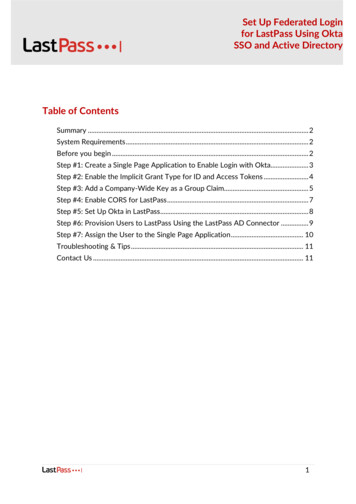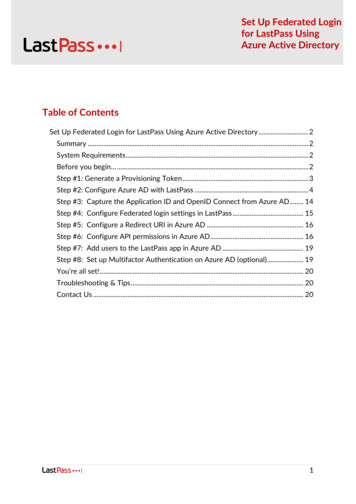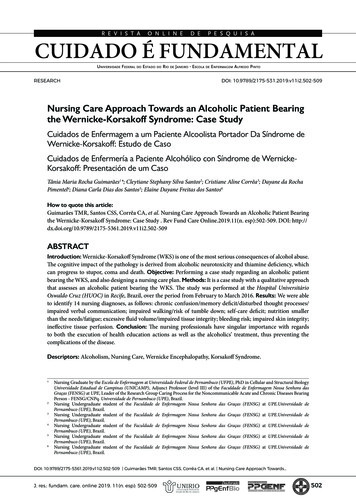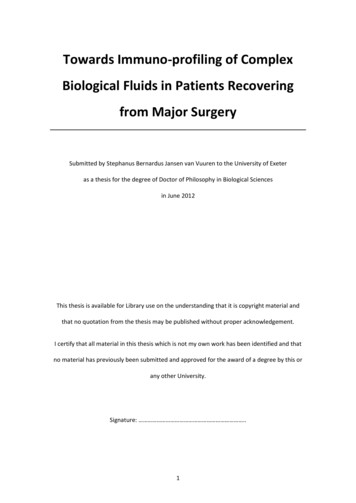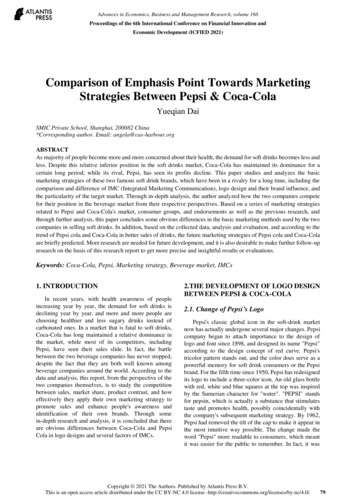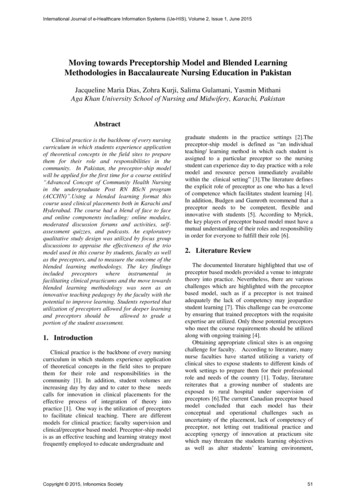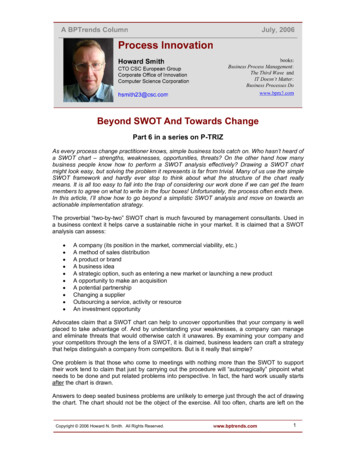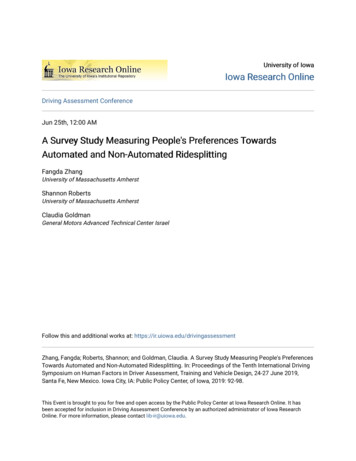
Transcription
Towards a Federated Framework forSelf-evolving Educational Experience Design on Massive Scale (SEED-M)an expanded and updated version of the draft submittedto the Knowledge Federation 2010 workshop,by George PórAbstractIf humankind is to pass its evolutionary test by meeting its global crises, (Nautilus Institute, 2009) alsoreferred to as the ―world problematique‖ (Meadows, 1972), it needs to grow competence in collectivesensemaking, self-reflexivity, and meaning-sharing, which are essential conditions for awakening its collectiveintelligence and ultimately, its self-awareness and sentience.The art and sciences of knowledge federation (KF) are pivotal enablers to accessing the lower levels of thatladder. Before we can step on rungs of collective sensemaking and self-reflexivity, KF has to help meeting thechallenge of the fragmentation of knowledge relevant to the global crises. We can transcend that fragmentationonly by the massive cooperation of all concerned. Given the scope of the crises, we are all concerned parties. Inthese conditions, for the scope of a knowledge federation project to be commensurate with the scope of thechallenge, it has to transcend academia and include it in a social learning journey with mass participation.In this paper, we propose to outline a framework for prototyping a federated, Self-evolving EducationalExperience Design on Massive Scale (SEED-M). In section 2, we introduce the SEED-M distinction, and insections 3 to 8 situate it in the context of social learning theory. Sections 9 and 10 are focused respectively, onissues of collective self-reflexivity and what it will take to prototype a SEED-M. The final; chapter is an outlineof some issues for further research.Table of ContentsThe structure of the paper consists of the following sections.1. Motivation and Contexts2. What Is in the SEED-M Meme?3. Collective Intelligence4. Social Theory of Learning5. Biomimicry-inspired Learning Theories6. Connectivism7. Wildfire Learning8. Crowd-Accelerated Innovation9. Federating Social Learning Theories for SEED-M10. Prototyping a Multi-Stakeholder SEED-MAppendix A Generative CapabilitiesReferences1. Motivation and ContextsThe motivation of writing this paper and the contexts to which it intends to contribute are two-fold. They areto:(1)(2)(3)Enhance the pedagogy of educational programs that involve social learning on a massive scale, and themethodology of designing such programsOutline a framework for prototyping a program designed to improve collective sensemaking and selfreflexivity in organizations and social movements (as pre-requisites to a global learning society)Start mapping critical issues in the Innovation Architecture of designing a collective intelligence portal2. What Is in the SEED-M Meme?
2A ―Self-evolving Educational Experience Design on Massive Scale‖ is pretty mouthful and needs to beunpacked to let us appreciate its richness. We define a SEED-M as an educational program, but not aninstructor driven course. ―Self-evolving,‖ in our context, refers to the fact that ―fresh strategic and designthinking is periodically brought to bear in a way that opens up unforeseen opportunities and benefits,‖ (Veltrop,T.) within an action-focused collaborative learning experience.―Self-evolving‖ is also a member of a family of distinctions that collectively describe ―generativity‖, a termused in organization design, as well as in community development strategies. Other members of the family willbe introduced in the prototyping section.When the ―self-evolving‘ distinction is applied to Educational Experience Design, it also implies learningthat is transformational, not simply adding new information to our knowledge but transforming and evolving ourcapabilities and consciousness, individual and collective. A SEED-M involves massive participation, up tothousands or tens of 1000 people who may or may not belong to the same organization or community, butwhose measure of success includes the augmentation of their collective intelligence capabilities.3. Collective IntelligenceJust as any complex phenomena, ―collective intelligence‖ (abbreviated as CI) can be looked at through manylenses and doing so, we will discover different meanings defined by their discipline-specific context or scope.The scopes that are particularly relevant to the intent of this writing are the evolutionary, socio-semantic, andcognitive. The sections below are an updated version of the corresponding sections of the Working Paper onCollective Intelligence and Collective Leadership: Twin Paths to Beyond Chaos (Pór, 2008).Evolutionary scope of collective intelligence―Collective intelligence" refers to the capacity of human groups of any size to evolve towards higher ordercomplexity and harmony, through such ―innovation mechanism‖ triads as ration-transformation, and competition-cooperation-coopetition.Evolution may not have a goal, but its direction towards higher order complexity is widely observed andpopularized by systems theory and the sciences of self-organization and complex adaptive systems in biology,economics, politics, language and management. Evolution is the unfolding of social holons in that direction,thanks to the innovation mechanism mentioned earlier. Thus, the evolution of any social holon— be it anorganization, a social system or movement, or humankind itself—entirely depends on its capacity to harmonizeits innovation mechanism triads.One can also look at evolutionary CI as a repertory of high-level, compound capabilities. Through that lens,this is what can be seen: "The capability of a collective/social system to hold questions and language toocomplex for any individual intelligence to hold, and to work out strategies, visions, goals, and images of adesired future, etc." (Voldtofte, F. 1997)The evolutionary scope is our broadest context for understanding CI. Continually increasing its evolutionaryCI is vital to the sustainability and thriveablity of any social holon in the conditions of accelerating changes inits habitat. Future-responsive governance systems steers adequate attention and resources to boost the group‘sevolutionary CI, which is needed to match the increasing complexity in its social environment.Socio-semantic scope of collective intelligenceThe concept of socio-semantic CI is derived from the Social Semantic Web that ―subsumes developments inwhich social interactions on the Web lead to the creation of explicit and semantically rich knowledgerepresentations. The Social Semantic Web can be seen as a Web of collective knowledge systems, which are
3able to provide useful information based on human contributions and which get better as more peopleparticipate.‖ (Gruber, 2006)Based on the above, we define the socio-semantic scope of collective intelligence as the one, in which social,conceptual, and technological systems co-evolve over time. When their interaction is designed for high synergy,it can power up the cognitive scope of CI.To realize that possibility, the commons (and other social holons) interested in boosting their CI need todevelop collective sensing and meaning-making organs and processes. For example: Mahatma Gandhi,discovered and appreciated that one cannot build a social movement without a newspaper that acts as a mirrorand a catalyst to its collective consciousness. His visionary genius today, would inspire the creation of sociosemantic web platforms for the commons to grow collaborative problem-solving and co-creation capabilities.Cognitive scope of collective intelligence"The expression 'collective intelligence' relates to an extensive body of knowledge and thoughts concernedwith several objects that have been diversely labeled: distributed cognition, distributed knowledge systems,global brain, super-brain, global mind, group mind, ecology of mind, hive mind, learning organization,connected intelligence, networked intelligence, augmented intelligence, hyper-cortex, symbiotic man, etc.Notwithstanding their diversity, these several rich philosophical and scientific contemporary trends have onefeature in common: they describe human communities, organizations and cultures exhibiting 'mind-like'properties, such as learning, perceiving, acting, thinking, problem-solving, and so on.‖ (Lévy, 2003a)―Intelligence refers to the main cognitive powers: perception, action planning and coordination, memory,imagination and hypothesis generation, inquisitiveness and learning abilities. The expression 'collectiveintelligence' designates the cognitive powers of a group." (Lévy, 2003a)The cognitive scope of CI outlined in those quotes describes a model of CI, which is, in reality, never actingalone, without the collective emotional and spiritual intelligence."[E]mphasis on cognition does not intend to diminish the essential roles of emotions, bodies, medias, signsystems, social relations, technologies, biological environment or physical support in collective intelligenceprocesses. The study of collective intelligence constitutes an inter-discipline aspiring as much to a dialoguebetween human and social sciences as with the technical, artistic and spiritual traditions. Its goal is to understandand improve collective learning and the creative process." (Lévy, 2003b)Seen through the evolutionary, socio-semantic and cognitive scopes, augmenting CI calls for meetingdifferent requirements in each three of them. In this paper we use the term mostly in its socio-semantic andcognitive scopes4. Social Theory of LearningThe social theory of learning and theories of social learning are two different but inter-related scopes. Thefirst is generated from the examination of the sociological contexts, in which learning and education happen.The second is more practice focused. It includes how groups adapt their learning practices to, or drive changes.The exploration of a social theory of learning has to precede the theories of social learning, because the scopeof the first can illuminate the issues, and help identifying gaps, in the second. A particular social theory oflearning, developed by Etienne Wenger, describes the emergence such trends as the "horizontalization oflearning" and "partialization of learning imperatives." Understanding both of them seems to be crucial to thesuccess of design thinking about massive social learning.
4"Horizontalization of learning: a shift in our a view of knowledge communication that emphasizes less thevertical relationship between a producer and a recipient and more horizontal interactions required for thenegotiation of mutual relevance.Partialization of learning imperatives: the complexity of knowledge domains creates relationships ofinterdependence so that learning increasingly means being part of broader systems and learning to participateproductively rather than mastering everything oneself." (Wenger 2004)We can observe the first trend in-action in the various forms of peer-to-peer learning, knowledge networks,communities of practice, and collective self-education in contemporary protest movements. The second trend,the partialization of learning imperatives, is expressed in the functional alignment and requisitecomplementarity of knowledge domains in modern organizations as much, as among the working groups of theGeneral Assembly in the big cities of the world, where the Occupy movement is active.Wenger's theory postulates a "curriculum of meaningfulness," of which he identified the following 7dimensions. (Wenger, 2004) We quote below all 7 of them because each can serve as a useful, generativestarting point to the design conversation. To encourage that conversation, we inserted some starter questionsunder each dimension of meaningfulness in the group members‘ experience, in italics."Experience of localized depth. Going deep into some learning, into the practice of a specific communityand get a good sense of what full membership is. Experience learning with others in the context of a community.Get far enough to experience peer-to-peer learning with masters of the practice.‖How to map the depth of knowledge available in and to a specific epistemic, professional, or activistcommunity, without diminishing its richness or getting lost in its details?“Experience of boundary crossing. Interaction across a boundary through engagement in a shared task thatforces cross-boundary negotiation.‖What knowledge federation tools can support communication, collaboration, and coordination of actionacross working groups of dissimilar working style and taxonomies?“Experience of time depth. Reach an experience of ―flow‖ by being fully present and creative in anactivity.‖What structural and interface characteristics of KF tools and processes are required to facilitate the“flow” experience of the group members?“Experience of time dislocation. Engage in a substantial contact with a different generation as a vista ontohistory or onto the future.‖In which ways can KF promote intergenerational learning in professional and political settings?“Experience of cultural dislocation. Immersion in a different culture with a different discourse of the self.‖How can KF mediate the negotiation of meaning across individuals and groups of dissimilar culture?“Experience of agency and power. Make a personal difference somewhere; not necessarily a great successin abstract terms; have an effect on the world that is experienced as personally significant.‖Can KF be used for the collaborative development of common indicators and metrics for assessing successfulcompletion of action in complex situations that involve multiple parties?
5“Experience of scale. This may be the most difficult to imagine and to achieve in practice. Hence its placelast. Gain an appreciation of a full learning system in which one is personally involved by traversing the fractalat multiple levels of scale. Learn to find the community structure. Understand in as direct a way as possible howthe levels con
4. Social Theory of Learning The social theory of learning and theories of social learning are two different but inter-related scopes. The first is generated from the examination of the sociological contexts, in which learning and education happen. The second is more practice focused. It includes how groups adapt their learning practices to, or .

